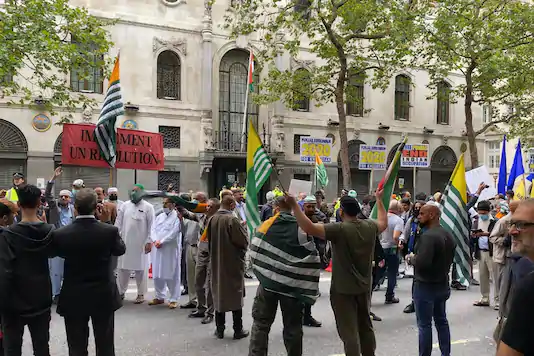
SOURCE: NEWS18
Anon-event is usually a non-story, but not always. The demonstration outside the Indian High Commission on Independence Day this year turned out to be a non-event. There couldn’t have been more than a hundred Pakistan-backed demonstrators who turned up to protest against the Indian government over Kashmir. But the small number tells a story, and it’s not just about the Covid times.
The turnout on August 15 was, in fact, even smaller than on August 5, when around 150 or so turned up on the anniversary of the revocation of Article 370. Since then, Covid-19 restrictions have eased further. To make room for a large number of expected demonstrators, the police had marked off several hundred metres of the road further across from India House to make room for potentially thousands.
Several thousands did turn up last year in a crowded, and then violent, protest. India House was pelted with eggs, tomatoes and stones. Window panes were smashed, some Indians around were roughed up. A year on, what brought the scale of protest down from that to this? A widely circulated poster and a mobilisation campaign suggests it was not for want of effort from local Pakistanis backed by the Pakistani High Commission.
Covid-19 was a factor to an extent, no doubt. But Covid has now settled down across Britain into quite small numbers over more than two months. Through this period, and through highs earlier as well, Britain has seen massive protests related to the Black Lives Matter movement, in London, Bristol and elsewhere. No Covid outbreaks were seen to have resulted from those angry protests. Any widely felt anger among Kashmiris from the Pakistani side could certainly have found far more expression than was seen on Saturday this week.
Undoubtedly, too, the protest last year was fed by immediate anger over a decision on Article 370 that had come just 10 days earlier. But to accept that would be also to accept that a lot of people are no more angry, or angry enough. The picture coming out of Jammu and Kashmir is not a settled one, but perhaps less unsettled than many may have feared a year ago. But any easing of anger over India is still only a part of the picture emerging now among Pakistani-Kashmiris in Britain.
DISILLUSIONMENT WITH PAKISTAN
A growing disillusionment with Pakistan is the other part. And that appears to have been growing sharply since publication of a new ‘map’ by the Pakistani government that makes a show of all of Kashmir as Pakistani territory, declared to be illegally occupied by India.
“The anti-India protests earlier were joined heavily by a number of groups who have been seeking self-determination for Kashmir,” Amjad Ayub Mirza, author and human rights activist told CNN-News18. “They are now feeling betrayed. All those Pakistani claims of supporting self-determination for Kashmir now stand naked. People who spoke self-determination are now nowhere to be seen at such protests.”
On August 14 this year, which Pakistan observes as its independence day, a protest was, in fact, held outside the Pakistani consulate in Bradford in the north of England.
“Protests were also held in front of other Pakistani consulates in Britain,” Mirza said.
Local reports and videos of these protests show clearly that many more Pakistani-Kashmiris turned out to protest against Pakistan than against India. Covid-19 did not stop the larger anti-Pakistan demonstrations.
Signals from Muzaffarabad have been creating difficulties for Pakistan. Pakistani-Kashmiris in Britain are looking at the differences that have been surfacing openly between Pakistan Prime Minister Imran Khan and the head of the Azad Jammu Kashmir (PoK) government Farooq Haider, says Mirza. “The Kashmiri community here is getting disheartened, there is a feeling of alienation from Pakistan.”
That feeling surfaces repeatedly in conversations with Pakistani-Kashmiris, and it’s beginning to show up on the streets. The Pakistani government seems rather good at scoring own-goals.






